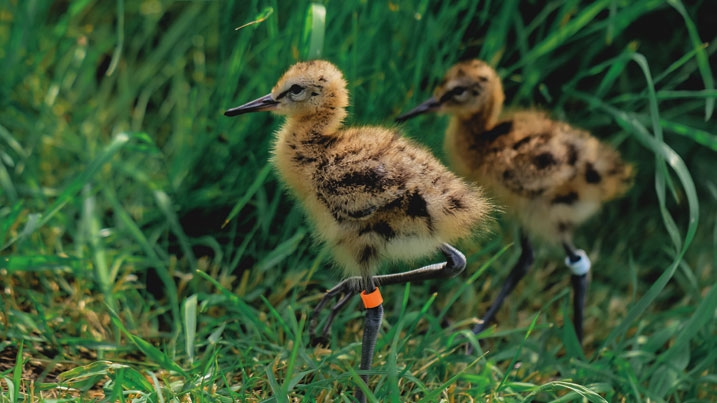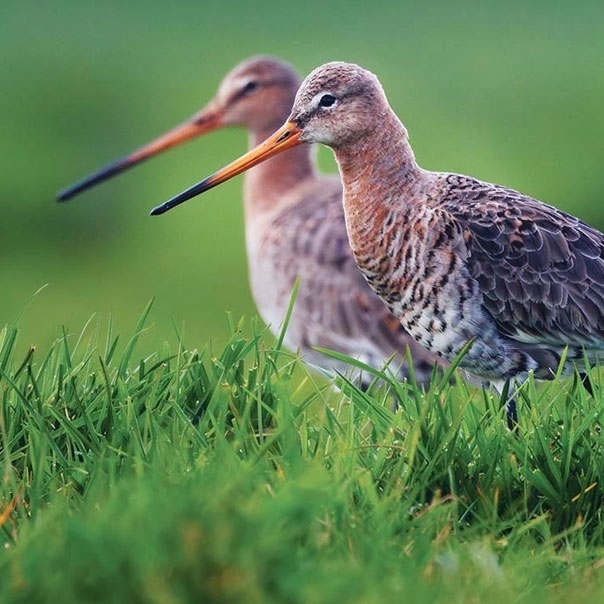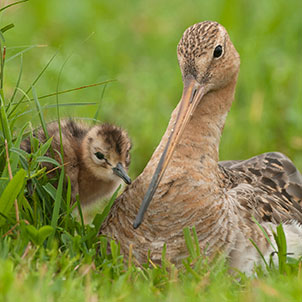Black-tailed godwits
These enigmatic wading birds mate for life but only meet up with their partner once a year. WWT is giving them a venue for their annual special date.
It’s one of nature’s most enduring romances.
Each year a couple of black-tailed godwits return to the wetland spot where they first met. They court, nest and hatch eggs. Exhausted, the mother quickly leaves. Dad feeds the hatchlings until they can feed themselves, then heads his own way too.
The couple will be separated by hundreds of miles the rest of the year. But next spring they will somehow return to their special place within three days of each other, to continue their brief annual affair. Loyal to the end, they may honour this annual date for up to 25 years.

The challenge
Romance can often turn to tragedy.
Eggs smashed and eaten, hatchlings drowned by rising floodwater and lonely birds confused by changed landscapes, unable to locate their estranged partner.

The black-tailed godwits’ main historic threat has been the draining of wetland habitat to provide land to grow food for humans. The birds have become concentrated into a few remaining spots, making them easy pickings for predators.
In the last 25 years, almost half of Europe’s black-tailed godwits have disappeared.
In order to tackle these challenges, Project Godwit was set up and active between 2017-2023 - a partnership between WWT and RSPB, working together for black-tailed godwits in the Fens. With major funding to help achieve vital conservation steps for the species and their wetland home.
Conservation in action
WWT created new pockets of wetland home for the black-tailed godwit to nest and feed in. We controlled water levels and put up anti-fox fencing to protect them.
We boosted chick numbers through a rear-and-release programme (headstarting) - a first of its kind. Using artificial incubation and protecting the hatchlings through their first vulnerable days, we can fledge three to four chicks from each nest, five times more than the birds can manage themselves. We released over two hundred birds.
We placed tiny tags on some chicks and rings on others so that we can better understand their movements. We were able to watch them follow in their parents’ wingbeats, meet other black-tailed godwits and begin lifelong romances of their own.
Geolocators fitted to birds throughout the project gave us an insight into their migration. Data showed that our godwits travelled all the way to West Africa and back, stopping off in Spain, Portugal and Norfolk on their way before returning back to the Fens to breed. We have found that saltmarsh, estuaries and mudflats are crucial for godwits along the flyway.
Research like this means that UK-based conservation teams can work with their equivalent organisations in other countries to ensure the birds have safe places to fly through or spend the colder months.

Godwit Futures - the next step
Throughout Project Godwit we have shown that our methods work for boosting small populations of godwits and we have these tools at our disposal.
The project as a whole has been successful in boosting the Ouse Washes population size by 800%. Our measures to increase breeding success in the wild have shown some success but not enough for godwits to be considered safe.
We’ve learned a lot more about the problems they’re facing and hopefully we can find solutions to these. With partners, we have created a ten year action plan to recover black-tailed godwits throughout England. This includes setting up the world's first conservation breeding programme for this species - the Godwit Futures project, where we aim to breed godwits in a safe, captive environment and reintroduce them to restored wetlands throughout England.
For godwits to thrive in the UK, we need bigger, better wetlands where there’s a balance between predators and prey.

Key achievements
- 235 hand-reared birds have been released into the wild during Project Godwit (2017-2022) and Godwit Futures (2024) – this boosted the Ouse Washes population by 800%.
- 51% of headstarted godwits have so far returned to the Ouse and Nene Washes since their release, which is comparable to wild-reared chicks.
- In 2024 there were 25 pairs breeding pairs on the Ouse Washes compared to three breeding pairs in 2017.
- Released godwits and wild-reared godwits have been recorded in 10 countries outside of the UK: France, Germany, Belgium, Netherlands, Austria, Spain, Portugal, Morocco, Senegal and Mauritania
- 7.5ha of wetland scrapes created and 70km of ditches reprofiled in the Fens
- >2,800ha of wetlands protected and managed for Fenland wildlife
- Installation of eel friendly pumps and investment in equipment for habitat management
- 2,500 godwit sightings in 10 countries
- Actively engaged over 2000 local people - 500 school children and 21 community groups signed up as Godwit Guardians

Partners and funders
Project Godwit was a partnership between RSPB and WWT with major funding from the EU LIFE Nature Programme, The HSBC 150th Anniversary Fund, Natural England and the Heritage Lottery Fund.





Godwit Futures works closely with the National Black-tailed Godwit Working Group with members from WWT, RSPB and Natural England. The project has received major funding from Natural England's Species Recovery Programme Capital Grant Scheme (SRPCGS).



